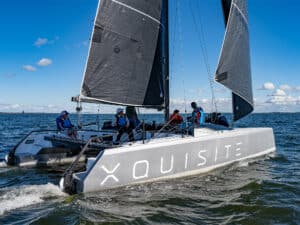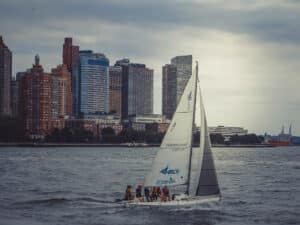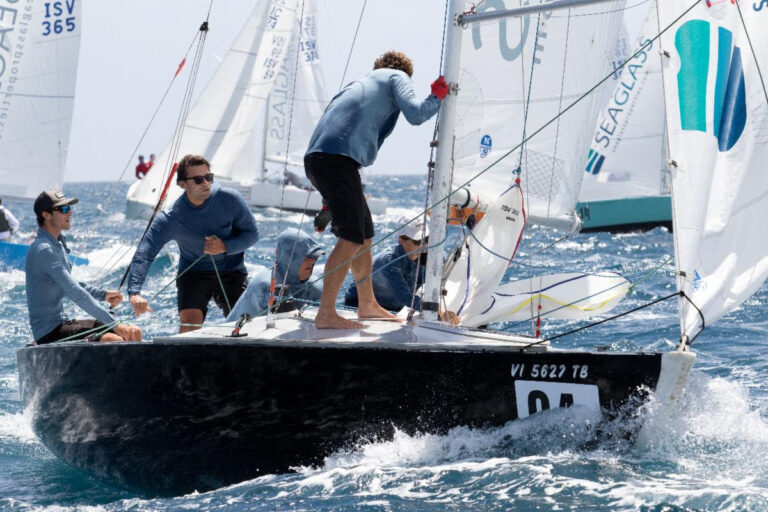
Perched on the shores of the deepwater Pensacola Bay, in the farthest northwest corner of the Florida Panhandle, the city of Pensacola had for years eluded the sailing spotlight. So-named for the long-haired indigenous inhabitants encountered by the Spanish explorers of the 1500s, Pensacola’s identity has ebbed and flowed with the tides. This City of Five Flags was abandoned for nearly a century after a hurricane wiped out its original Spanish inhabitants, to later be governed by France, Great Britain, the US and the Confederate States of America.
A significant economic contributor to Florida for timber and fishing in the 1930s and 1940s, Pensacola’s sailing culture flourished in the decades that followed but fell dormant in the aftermath of the 1970s and 1980s hurricanes, which once again drove an entire generation elsewhere.
With a history as turbulent as the hurricanes that defined it, the city on the bay is rising again, this time capitalizing on its distinguishing geographic features.
Immediate past commodore of the Pensacola Yacht Club Tom Pace knows the city—and its bay—quite well. The once-professional windsurfer grew up in Pensacola, moved away during the aforementioned dormant years, but returned to care for his ailing parents. His love for Pensacola inspired a Quixote-esque quest to showcase the bay’s ideal location and sailing conditions.
Spanning roughly 5-by-11 miles in depths of 22 to 32 feet, Pensacola Bay’s sail-racing area takes advantage of the optimal sailing conditions. Here, wind conditions vary from season to season, but serve up a perfect 8.1 mph average punctuated by 15 to 25 mph frontal surges between October and May. The warmer months see light winds in the morning building into a southwesterly sea breeze later in the day.

The bay has been home to several notable youth sailing events in recent years, including the 2018 Optimist National Championship and the US Sailing Youth National Championship, as well as a host of national and international regattas.
“It had been a dream for years,” Pace says. “We are trying to rebuild a sailing culture.”
Pace’s vision coincided with the brewing of the perfect storm—one propelled by the New York Yacht Club’s decision to challenge the 36th America’s Cup. Led by three-time Maxi72-class champion and yachtsman John “Hap” Fauth, businessman Roger Penske and Quantum Racing head Doug DeVos, the AC Cup Challenger team American Magic was looking for a training base. Key West offered the infrastructure but temperamental conditions. Pensacola’s protected bay, on the other hand, offered conditions similar to Auckland’s Hauraki Gulf.
“We kept bugging American Magic to relocate from Key West to Pensacola,” Pace says. “The bay offers winds from every direction and, unlike San Francisco or New York, it’s not as seasonal. The cost of living factors in as well.” Team representative Dr. Jim Andrews visited during a particularly stellar 40-knot day. “We got a call a month later from Tyson Lamont (WHO). They would need a dock, containers, and stakes for tent structures for the AC36 Challenger team who would use Pensacola Bay as its winter training base, named Warehouse 10.
“In the 1984 Olympics, the US took gold or silver in each of 12 sailing medal divisions,” said Pace. “Since then we’ve fallen off; during the past three Olympic cycles, the US has had one medal. Hap and Doug saw this stagnation of American sailing and went back to the cradle. They needed a performance sailing center.”
In 2020, the biggest names in American sailing turned their attention not only to US sailing, but to Pensacola as well. Names such as Paul Cayard, Dawn Riley, Ray Palmer, Terry Hutchinson, and Mike Cazer were each influential in the fledgling opti, foils, and Moth events now surging on the bay.

This year, Pace’s vision for Pensacola came one step closer to reality when the board of Triumph Gulf Coast voted unanimously to approve an $8.5 million grant for design, renovation, and completion of the American Magic training facility. The new Center for Maritime Excellence will serve as the permanent headquarters for the American Magic team. On top of this, Florida Governor Ron DeSantis announced a $3.9 million grant from the Florida Job Growth Grant Fund to strengthen Pensacola’s infrastructure and “promote economic opportunities in the sailing industry for the Florida Panhandle.”
“There is a lot of excitement here now that real hard dollars are going into our vision,” says Pace. “None of this would have been possible without Merrill Land Company President/Owner Collier Merrill at the state level and Ellis Bullock, President/Creative Director of marketing and communications firm EW Bullock on the local level. Without them we would not have begun the sponsorship of American Magic. In fact, Pensacola, Florida will now be displayed on the sails through the Cup Finals. They have been critical to the relationship with local leaders as well as with the Governor, Florida Senators and Congressmen, and remain the bedrock of all of this.
“Our task now is to build out the infrastructure,” says Pace. “The marina space may be a challenge but the water is not. There is a load of potential in revitalizing the waterfront as well as downtown Pensacola.”
Now that the momentum is going, Pace can already taste an American Magic win in Barcelona. “If American Magic wins, how do we shape up the defense in Pensacola? There is a lot of excitement. We need tourist development and the county engaged, if it’s all going to work. What we have is an incredibly cohesive core group that we hope will influence the ancillaries. Everything has been set, we have legitimate money, everybody is in. If you build a little bit of infrastructure, you will attract a lot.”
Godspeed, Pensacola. We’ll see you on the bay.
To learn more about Pensacola sailing visit www.visitpensacola.com/feature/sailing/.









